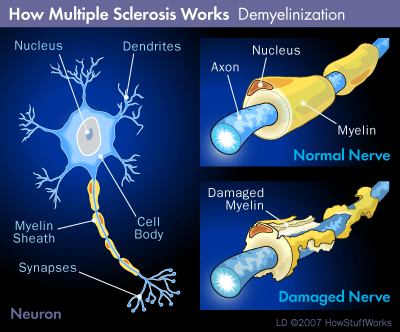
xx
The disease:
Multiple sclerosis (MS) is an auto-immune disease characterized by episodes of multi-focal inflammation and demyelination of the brain and spinal cord, leading to recurrent and unpredictable neurologic compromise (relapses or exacerbations), usually alternating with periods of disease inactivity (remissions).
xx
The drug:
Tysabri (natalizumab) is a monoclonal antibody that binds to the cell adhesion molecules involved in the white blood cell movement from the blood stream into the central nervous system across the “blood-brain barrier”.
Keeping these cells out of the brain and spinal cord can help prevent the immune-mediated inflammation and demyelination that leads to clinical relapses in multiple sclerosis.
Studies have shown that patients taking Tysabri have a 64% reduced risk of disability progression and >80% fewer exacerbations (relapses) compared to placebo. More than 1/3 patient who take the drug are clinically free of disease activity.
Tysabri is administered by iv infusion once a month.
xx
The problem:
More than 50% of people have been infected with the JC or John Cunningham) virus (JCV), most during childhood or adolescence, often with no symptoms at all or just a minor febrile illness.
Once infected, the virus then lies dormant in the central nervous system, like a Tojan horse, totally inactive and innocuous.
However, if the infected person becomes immune suppressed, for example from HIV infection (AIDS) or from taking a immune presupposing medication, the virus can become reactivated and lead to a very serious brain infection known as Progressive multifocal leukoencephalopathy (PML). PML leads to large confluent areas of brain infection and demyelination (below), causing disability and death,

Large confluent areas of demyelination in PML.
When a few Tysabri patients developed PML during the initial clinical trials, the FDA temporarily pulled the drug, but then re-introduced it with more careful monitoring (the TOUCH porgram).
xx
I’m taking Tysabri, what’s my risk of PML?
There have now been >350 cases of PML in MS patients taking Tysabri, and this constitutes an overall risk of about 1.5 cases per 1000 (or 0.15%) of those taking the drug.
The risk is higher for patients who have already been been exposed to (and test positive for) JCV, have taken other immunosupressive drugs, or have taken Tysabri for longer times:
So, if you take Tysabri but test -ve for JCV, your PML risk is 0.07 per 1000, or 0.007% or 1 in 14,000.
Even if you test positive for JCV but haven’t taken prior immunosupressive meds (like azathioprine, methotrexate or mycophenolate) your PML risk is only 0.6 per 1000 or 0.06% or 1 in 1,700.
xx
So, what should I do?
If you take Tysabri, you should know your JCV status. If your negative, you should get re-tested every 6-months since there are false negative results and some people do seroconvert every year.
If (or once) you test positive, you don’t need any further blood tests, but you should carefully weigh the risk benefits of continuing to take Tysabri beyond 2 years, particularly if you have had prior exposure to other immunosupressive drugs.
Click here to find out more about Tysabri and PML from the MS society.






























